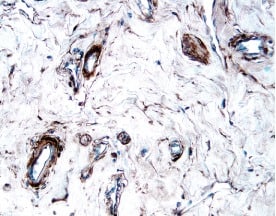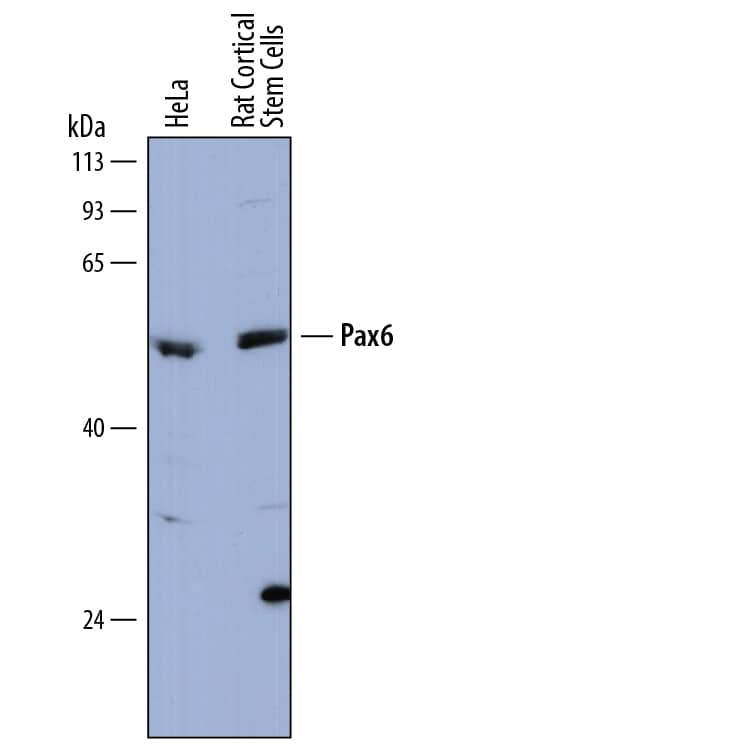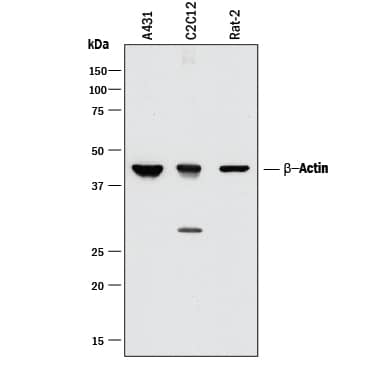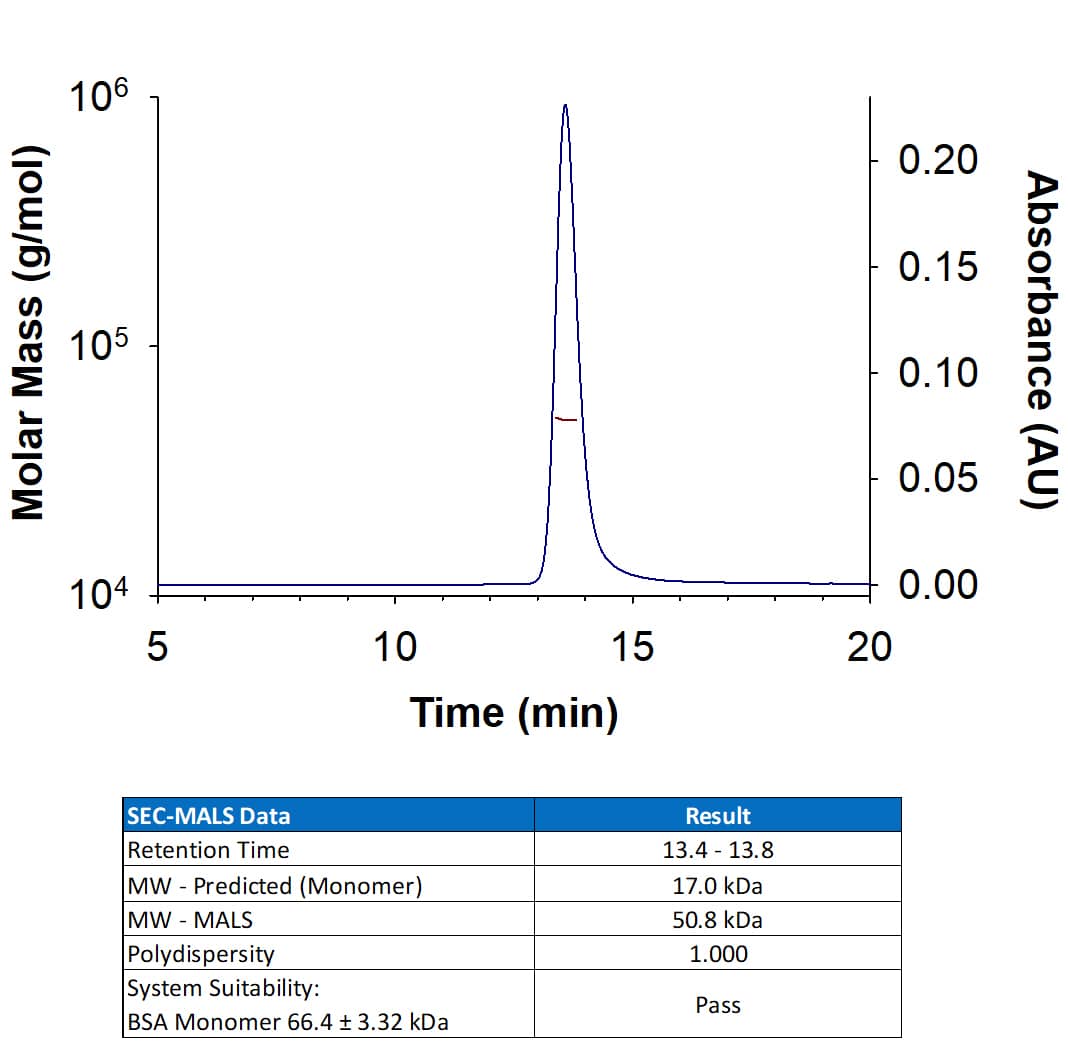Human Aminopeptidase N/CD13 Antibody Summary
Lys69-Lys967
Accession # AAA51719
Customers also Viewed
Applications
Please Note: Optimal dilutions should be determined by each laboratory for each application. General Protocols are available in the Technical Information section on our website.
Scientific Data
 View Larger
View Larger
Detection of Human Aminopeptidase N/CD13 by Western Blot. Western blot shows lysates of human kidney tissue and human prostate tissue. PVDF membrane was probed with 2 µg/mL of Mouse Anti-Human Aminopeptidase N/CD13 Monoclonal Antibody (Catalog # MAB3815) followed by HRP-conjugated Anti-Mouse IgG Secondary Antibody (Catalog # HAF018). A specific band was detected for Aminopeptidase N/CD13 at approximately 150 kDa (as indicated). This experiment was conducted under reducing conditions and using Immunoblot Buffer Group 1.
 View Larger
View Larger
Aminopeptidase N/CD13 in SH-SY5Y Human Cell Line. Aminopeptidase N/CD13 was detected in immersion fixed SH-SY5Y human neuroblastoma cell line using Mouse Anti-Human Aminopeptidase N/CD13 Monoclonal Antibody (Catalog # MAB3815) at 8 µg/mL for 3 hours at room temperature. Cells were stained using the NorthernLights™ 557-conjugated Anti-Mouse IgG Secondary Antibody (red; Catalog # NL007) and counterstained with DAPI (blue). Specific staining was localized to cytoplasm and plasma membranes. View our protocol for Fluorescent ICC Staining of Cells on Coverslips.
 View Larger
View Larger
Aminopeptidase N/CD13 in Human Liver Cancer Tissue. Aminopeptidase N/CD13 was detected in immersion fixed paraffin-embedded sections of human liver cancer tissue using 25 µg/mL Mouse Anti-Human Aminopeptidase N/CD13 Monoclonal Antibody (Catalog # MAB3815) overnight at 4 °C. Tissue was stained with the Anti-Mouse HRP-DAB Cell & Tissue Staining Kit (brown; Catalog # CTS002) and counterstained with hematoxylin (blue). View our protocol for Chromogenic IHC Staining of Paraffin-embedded Tissue Sections.
 View Larger
View Larger
Aminopeptidase N/CD13 in Human Brain. Aminopeptidase N/CD13 was detected in immersion fixed paraffin-embedded sections of human brain (cortex) using Mouse Anti-Human Aminopeptidase N/CD13 Monoclonal Antibody (Catalog # MAB3815) at 1.7 µg/mL overnight at 4 °C. Tissue was stained using the Anti-Mouse HRP-DAB Cell & Tissue Staining Kit (brown; Catalog # CTS002) and counterstained with hematoxylin (blue). Specific staining was localized to blood vessels. View our protocol for Chromogenic IHC Staining of Paraffin-embedded Tissue Sections.
 View Larger
View Larger
Detection of Human Aminopeptidase N/CD13 by Simple WesternTM. Simple Western lane view shows lysates of human small intestine tissue and human prostate tissue, loaded at 0.5 mg/mL. A specific band was detected for Aminopeptidase N/CD13 at approximately 204 kDa (as indicated) using 40 µg/mL of Mouse Anti-Human Aminopeptidase N/CD13 Monoclonal Antibody (Catalog # MAB3815). This experiment was conducted under reducing conditions and using the 12-230 kDa separation system.
 View Larger
View Larger
Western Blot Shows Human Aminopeptidase N/CD13 Specificity by Using Knockout Cell Line. Western blot shows lysates of U937 human histiocytic lymphoma cell line and human APN knockout U937 human histiocytic lymphoma cell line (KO). PVDF membrane was probed with 2 µg/mL of Mouse Anti-Human Aminopeptidase N/CD13 Monoclonal Antibody (Catalog # MAB3815) followed by HRP-conjugated Anti-Mouse IgG Secondary Antibody (HAF018). A specific band was detected for Aminopeptidase N/CD13 at approximately 150 kDa (as indicated) in the parental U937 human histiocytic lymphoma cell line, but is not detectable in knockout U937 human histiocytic lymphoma cell line. GAPDH (MAB5718) is shown as a loading control. This experiment was conducted under reducing conditions and using Western Blot Buffer Group 1.
Preparation and Storage
- 12 months from date of receipt, -20 to -70 °C as supplied.
- 1 month, 2 to 8 °C under sterile conditions after reconstitution.
- 6 months, -20 to -70 °C under sterile conditions after reconstitution.
Background: Aminopeptidase N/CD13
The human ANPEP gene encodes aminopeptidase N (APN), which is also known as microsomal aminopeptidase, alanyl aminopeptidase, aminopeptidase M, CD13, or membrane protein p161 (1‑3). The deduced amino acid sequence of human APN consists of a short cytoplasmic tail (residues 2 to 8), a transmembrane region (residue 9 to 32), a Ser/Thr rich region and a zinc metalloprotease domain (residues 69 to 966). The amino acid sequence of human APN is 78% and 77% identical to that of rat and mouse, respectively. Widely expressed in many cells, tissues and species, APN cleaves the N-terminal amino acids from bioactive peptides, leading to their inactivation or degradation. The roles of APN in many fields, such as neuroscience, hematopoeitic cells, immune system, angiogenesis, cancer and viral infection, have been reviewed (3).
- Olsen, J. et al. (1988) FEBS Lett. 238:307.
- Look, A.T. et al. (1989) J. Clin. Invest. 83:1299.
- Turner, A.J. (2004) in Handbook of Proteolytic Enzymes (ed. Barrett, et al.) pp. 289, Academic Press, San Diego.
Product Datasheets
Citations for Human Aminopeptidase N/CD13 Antibody
R&D Systems personnel manually curate a database that contains references using R&D Systems products. The data collected includes not only links to publications in PubMed, but also provides information about sample types, species, and experimental conditions.
6
Citations: Showing 1 - 6
Filter your results:
Filter by:
-
Reductions in brain pericytes are associated with arteriovenous malformation vascular instability
Authors: EA Winkler, H Birk, JK Burkhardt, X Chen, JK Yue, D Guo, WC Rutledge, GF Lasker, C Partow, T Tihan, EF Chang, H Su, H Kim, BP Walcott, MT Lawton
J. Neurosurg., 2018-12-01;0(0):1-11.
Species: Human
Sample Types: Whole Tissue
Applications: IHC-P -
Blood-brain barrier-associated pericytes internalize and clear aggregated amyloid-?42 by LRP1-dependent apolipoprotein E isoform-specific mechanism
Authors: Q Ma, Z Zhao, AP Sagare, Y Wu, M Wang, NC Owens, PB Verghese, J Herz, DM Holtzman, BV Zlokovic
Mol Neurodegener, 2018-10-19;13(1):57.
Species: Human
Sample Types: Whole Tissue
Applications: IHC-P -
Post-Translational Modification of Adiponectin Affects Lipid Accumulation, Proliferation and Migration of Vascular Smooth Muscle Cells
Authors: X Chen, Y Yuan, Q Wang, F Xie, D Xia, X Wang, Y Wei, T Xie
Cell. Physiol. Biochem., 2017-08-28;43(1):172-181.
Species: Human
Sample Types: Plasma
Applications: Western Blot -
Fungal lectin MpL enables entry of protein drugs into cancer cells and their subcellular targeting
Authors: S Å Urga, MP Nanut, J Kos, J Saboti?
Oncotarget, 2017-04-18;8(16):26896-26910.
Species: Human
Sample Types: Cell Lysates, Whole Cells
Applications: Co-Immunoprecipitation, ICC -
Involvement of a di-leucine motif in targeting of ABCC1 to the basolateral plasma membrane of polarized epithelial cells.
Authors: Emi Y, Harada Y, Sakaguchi M
Biochem Biophys Res Commun, 2013-10-12;441(1):89-95.
Species: Human
Sample Types: Whole Cells
Applications: IHC -
Potentials and capabilities of the Extracellular Vesicle (EV) Array.
Authors: Jorgensen MM, Baek R, Varming K.
J Extracell Vesicles
FAQs
No product specific FAQs exist for this product, however you may
View all Antibody FAQsIsotype Controls
Reconstitution Buffers
Secondary Antibodies
Reviews for Human Aminopeptidase N/CD13 Antibody
Average Rating: 5 (Based on 1 Review)
Have you used Human Aminopeptidase N/CD13 Antibody?
Submit a review and receive an Amazon gift card.
$25/€18/£15/$25CAN/¥75 Yuan/¥2500 Yen for a review with an image
$10/€7/£6/$10 CAD/¥70 Yuan/¥1110 Yen for a review without an image
Filter by:



















